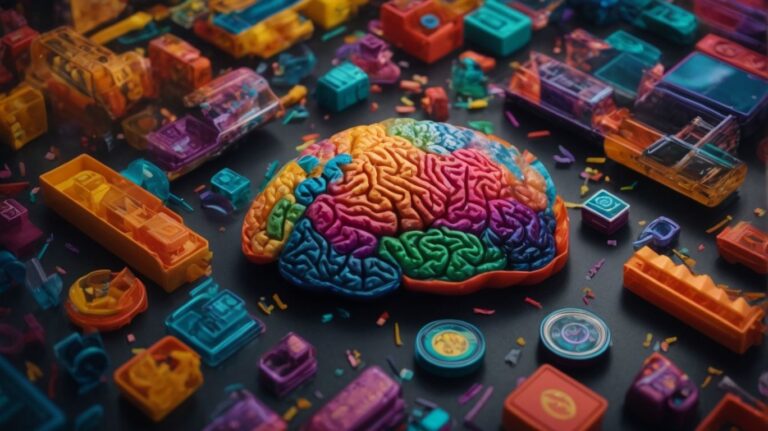Have you ever wondered how to tell if someone likes you without them saying a word? Nonverbal communication plays a crucial role in understanding the subtle cues that indicate attraction or disinterest.
In this article, we will explore the different types of nonverbal cues, how psychology can help decipher them, and the key indicators of attraction and rejection. By learning to read and interpret body language, you can navigate interpersonal relationships with more insight and understanding.
Contents
- 1 What is Nonverbal Communication?
- 2 How Can Psychology Help in Understanding Nonverbal Cues?
- 3 How to Read and Interpret Body Language?
- 4 What are the Psychological Reasons Behind Nonverbal Cues?
- 5 How to Use Nonverbal Cues to Determine if Someone Likes You?
- 6 Conclusion: Applying Psychology to Decode Nonverbal Cues in Interpersonal Relationships
- 7 Frequently Asked Questions
- 7.1 What are some common signs that someone likes you, according to psychology?
- 7.2 Why is deciphering signs important in understanding if someone likes you?
- 7.3 Is it possible for someone to fake the signs of liking you?
- 7.4 What is the role of body language in deciphering signs?
- 7.5 Are there any specific verbal cues that can reveal if someone likes you?
- 7.6 Can deciphering signs of attraction be accurate 100% of the time?
What is Nonverbal Communication?
Nonverbal communication refers to the transmission of feelings, thoughts, or information without the use of words, primarily through body language, gestures, and facial expressions.
It plays a crucial role in human interaction as it helps individuals convey their emotions and intentions effectively. For instance, eye contact can indicate interest, respect, or even attraction without any verbal cues. Understanding nonverbal cues is closely linked to psychology as it involves interpreting subtle signals beyond spoken language. The way someone gestures or maintains posture can reveal a lot about their mood or attitude in a given situation. Mastering the art of nonverbal communication can lead to more harmonious relationships and successful social interactions.
What are the Different Types of Nonverbal Cues?
Nonverbal cues encompass a wide range of expressions and signals, including gestures, proximity, touch, and verbal cues that can convey messages, emotions, and intentions effectively.
One of the most common nonverbal cues is gestures. These can vary widely from culture to culture, with some gestures having different meanings in different contexts. For instance, a simple head nod can mean agreement in one culture but disagreement in another. It’s crucial to be mindful of these variations when interpreting gestures during a conversation with friends.
Touch is another powerful nonverbal cue that can communicate warmth, empathy, or even boundary-setting. A gentle pat on the back can convey support and care, while a firm handshake can signal confidence and respect.
How Can Psychology Help in Understanding Nonverbal Cues?
Psychology plays a crucial role in decoding nonverbal cues by analyzing behaviors, signals, and patterns associated with eye contact, touch, and other nonverbal communication aspects.
Interpreting nonverbal cues involves a deep understanding of human behavior and the complex interplay between conscious and unconscious signals. Body language can speak volumes about a person’s emotions, intentions, and attitudes, often revealing more than words can convey. By observing microexpressions, posture shifts, and gesture timing, psychologists can gain profound insights into an individual’s inner thoughts and feelings. This intricate dance of nonverbal communication highlights the intricacies of human interaction, shedding light on unspoken cues that shape our daily exchanges.
What are the Key Indicators of Attraction?
Key indicators of attraction often include emotional connection, genuine interest, positive posture, facial expressions, and the exchange of compliments, fostering the development of meaningful relationships.
When two individuals share an emotional bond, it forms a strong foundation for a potential relationship. The sincerity and curiosity displayed through genuine interest play a crucial role in deepening this connection.
Observing positive postures like leaning in, maintaining eye contact, or mirroring body language can further enhance the sense of attraction between them. Facial expressions, such as smiles, raised eyebrows, or dilated pupils, can reveal underlying emotions and interests, fostering a sense of mutual understanding.
Compliments, when given sincerely, not only boost self-esteem but also strengthen the bond by showing appreciation and admiration.
What are the Nonverbal Cues of Disinterest or Rejection?
Nonverbal cues of disinterest or rejection may manifest through closed body language, lack of engagement, and subtle changes in tone of voice, impacting the level of intimacy and understanding in interactions.
When someone folds their arms or avoids eye contact during a conversation, it often signifies a lack of interest or disagreement.
A decreased level of engagement such as minimal nodding or short responses can indicate disinterest in the interaction. Subtle variations in tone of voice, like a monotone delivery or abrupt speech, can further reinforce feelings of disconnection. These cues collectively contribute to a shift in the dynamics of the interaction, potentially hindering the development of deeper connections between friends or acquaintances.
How to Read and Interpret Body Language?
Reading and interpreting body language involves analyzing psychological cues, observing proximity, gestures, and interactions, and interpreting emotional responses to decipher unspoken messages effectively.
When analyzing psychological cues in body language, it’s essential to pay attention to micro-expressions, subtle shifts in posture, and eye movements.
Proximity analysis plays a crucial role in understanding the comfort level or intimacy between individuals during communication. Gestures such as hand movements, facial expressions, and body positioning can reveal underlying emotions and attitudes.
Emotional responses like blushing, sweating, or fidgeting provide valuable insights into a person’s true feelings, often contradicting their verbal statements. By considering these aspects, one can gain a deeper understanding of nonverbal communication and improve overall interpersonal interactions.
What are the Different Body Language Signals?
Body language signals encompass a wide array of cues that convey attraction, availability, fertility, and attractiveness, influencing interpersonal dynamics and relationship development.
When we dive into the intricacies of body language, we can observe subtle gestures that play a significant role in indicating interest and desirability. For instance, prolonged eye contact is often associated with attraction, showcasing a person’s focus and genuine interest in their interaction. Furthermore, smiling is a universal expression of warmth and approachability, instantly enhancing one’s attractiveness and likability. Leaning in towards someone during a conversation can signal openness and engagement, fostering a deeper connection and demonstrating availability. These non-verbal cues, when combined, create a powerful tapestry that helps in establishing and nurturing meaningful relationships.
How to Differentiate Between Genuine and Fake Body Language?
Distinguishing between genuine and fake body language involves observing nuances in gestures, expressions, and actions to gain insight into underlying intentions, offering valuable advice and enhancing interpersonal impact.
Focusing on these subtle cues can reveal much about a person’s true feelings and thoughts. It’s not just about the obvious signals but also the micro-expressions that flicker across their face momentarily. These fleeting gestures can speak volumes about what someone is truly feeling, often contradicting their spoken words. By paying attention to these intricacies, one can navigate social interactions more effectively and build better connections based on genuine understanding and empathy.
What are the Psychological Reasons Behind Nonverbal Cues?
The psychological reasons underlying nonverbal cues often stem from a person’s feelings, subconscious signals, textual interpretations, and the dynamics of relationships, serving as a guide to understanding unspoken communication.
When looking into personal emotions, nonverbal cues can reflect a plethora of feelings – from joy and excitement to anxiety and sadness. These emotional states often manifest through facial expressions, body language, and even the tone of voice, providing valuable insights into an individual’s inner world. In terms of textual clues, the way messages are conveyed through written or spoken words can significantly influence how nonverbal cues are perceived. This interplay between verbal and nonverbal communication underscores the complexity of human interaction and the intricate nature of relationships.
How Do Cultural Differences Affect Nonverbal Communication?
Cultural differences significantly impact nonverbal communication by shaping behaviors, relationships, expressions, and the interpretation of signs and signals, highlighting the complexity of cross-cultural interactions.
Attraction cues, for instance, can vary widely between cultures; what may be perceived as a friendly gesture in one society might be seen as offensive in another. In some cultures, maintaining eye contact signifies sincerity and attentiveness, while in others, it could be considered confrontational. It’s fascinating how simple signs like a smile or a nod can carry vastly different meanings across different cultural contexts.
What are the Psychological Factors that Influence Nonverbal Cues?
Psychological factors play a significant role in shaping nonverbal cues, offering valuable advice, insights, and understanding of the impact of actions and intentions on interpersonal communication dynamics.
One key aspect is the influence of emotions on nonverbal behavior; specific emotions can manifest in different physical expressions, gestures, and facial microexpressions, providing important clues about one’s internal state.
Cultural backgrounds and societal norms also contribute to the interpretation of nonverbal cues. What may be acceptable in one culture could be perceived differently in another, leading to misunderstanding or miscommunication.
It’s essential to be mindful of body language, tone of voice, and facial expressions, as these can heavily influence how a message is received by others.
How to Use Nonverbal Cues to Determine if Someone Likes You?
Deciphering nonverbal cues to assess if someone likes you involves analyzing eye contact, signs of attraction, emotional cues, instinctual responses, and subconscious signals that convey underlying feelings and interests.
In terms of eye contact, prolonged gazes can signify interest or attraction, while breaking eye contact could show shyness or nerves. Interpreting attraction signals such as mirroring body language or leaning in during conversation can be key indicators. Emotional expressions like smiling, blushing, or dilated pupils can reveal genuine feelings. Our instincts often pick up on subtle cues that our conscious mind may miss, such as fidgeting or playing with hair. Being attuned to these subconscious cues can offer a deeper understanding of someone’s true feelings towards you.
Conclusion: Applying Psychology to Decode Nonverbal Cues in Interpersonal Relationships
Leveraging psychological insights to decode nonverbal cues is instrumental in navigating interpersonal relationships, understanding people’s emotions, behaviors, and the subtle signals that guide meaningful connections.
Nonverbal communication plays a crucial role in conveying unspoken messages that words alone cannot express. By applying psychological principles, individuals can develop a deeper understanding of the underlying emotions and intentions behind gestures, facial expressions, and body language. This awareness not only enhances empathy but also fosters stronger bonds based on mutual respect and understanding.
Frequently Asked Questions
What are some common signs that someone likes you, according to psychology?
Some common signs include prolonged eye contact, mirroring your body language, using open and welcoming body language, and finding excuses to touch you.
Why is deciphering signs important in understanding if someone likes you?
Deciphering signs can give insight into someone’s true feelings, allowing you to make informed decisions about your relationship and potential compatibility.
Is it possible for someone to fake the signs of liking you?
Yes, it is possible for someone to fake signs of liking you. This could be for various reasons, such as trying to impress you or manipulating you for their own gain.
What is the role of body language in deciphering signs?
Body language plays a significant role in deciphering signs of attraction, as it is often a subconscious way for someone to express their feelings and intentions.
Are there any specific verbal cues that can reveal if someone likes you?
Yes, some verbal cues that can indicate someone’s interest in you include them asking personal questions, using flirtatious language, and giving compliments.
Can deciphering signs of attraction be accurate 100% of the time?
No, deciphering signs of attraction is not a foolproof method of determining if someone likes you. It is important to also consider the context of the situation and the individual’s behavior and actions as a whole.


